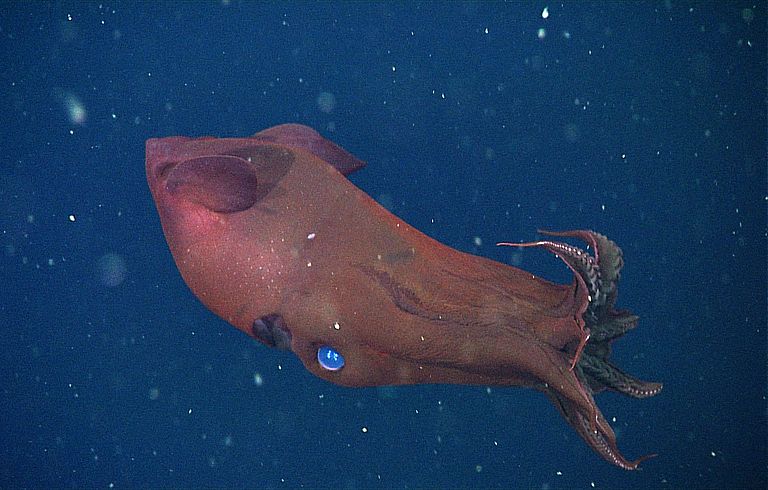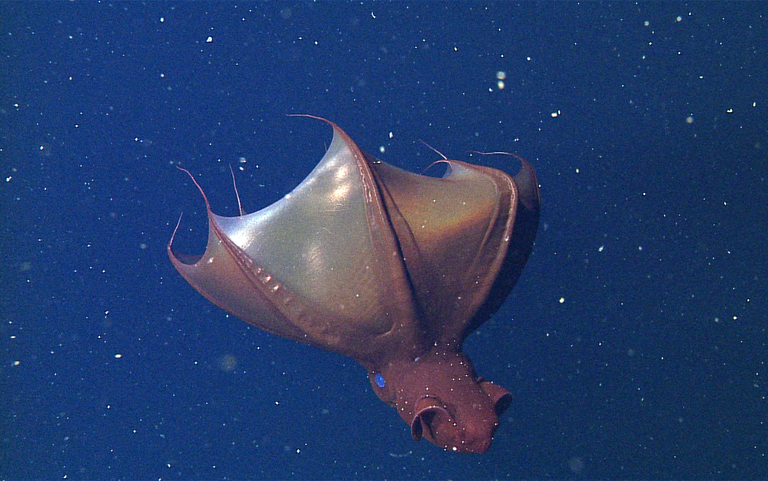Vampire Squid: The first Time is not the last Time
New study in Current Biology shows multiple reproductive cycles of deep-sea squid
Among soft-bodied cephalopods, vampire squid live life at a slower pace. At ocean depths from 500 to 3,000 meters, they don’t swim so much as float, and they get by with little oxygen while consuming a low-calorie diet of zooplankton and detritus. Now, researchers reporting in the Cell Press journal Current Biology on April 20 have found that vampire squid differ from all other living coleoid cephalopods in their reproductive strategy as well.
While other squid reproduce all at once late in their lives, vampire squid appear to alternate between reproductive and resting phases. It’s a pattern of multiple spawning more common among fish.
“Their slow mode of life seems insufficient to support one big reproductive event, unlike other coleoid cephalopods,” says Henk-Jan Hoving of GEOMAR Helmholtz Centre for Ocean Research Kiel in Germany. “Perhaps it is therefore that vampire squid return to a gonadal resting phase after spawning, and presumably start accumulating energy for a new reproductive cycle.”
Hoving and his colleagues were led to the discovery quite by accident as they were going through vampire squid collections dating back to the 1960s and 1970s at the Santa Barbara Museum of Natural History. They noticed something unexpected along the way: many of the females had spawned but had no ripe or developing eggs and were in a reproductive resting phase.
The researchers have now characterized the reproductive status of more than 40 vampire squid females. They report that one female in the sample, despite being in a reproductive resting phase, had released at least 3,800 eggs yet still retained 6,500 viable oocytes for future spawning. Assuming an average batch size of 100 eggs, the researchers suggest that this one female had already spawned about 38 times, with eggs in reserve for another 65 or so spawning episodes.
The findings suggest that vampire squid live longer than shallow-water squid species typically do. The discovery is also a reminder of just how much we have to learn about life in the deep sea.
“We know very little about deep-sea organisms and their life-cycle patterns, in particular in the water column of the deep sea,” Hoving says. “The patterns we know from coastal and shallow-water organisms may not apply to deep-sea species. We need to enhance our knowledge of deep-sea pelagic organisms and the system they are part [of], since the pelagic deep sea is the largest living space on the planet. A better understanding of this unique marine ecosystem will eventually allow for better development of management and conservation strategies.”
(English version based on a Cell Press press release)
Reference:
Hoving, H.-J., V. V. Laptikhovsky, B. H. Robison (2015): Vampire squid reproductive strategy is unique among coleoid cephalopods. Current Biology, http://dx.doi.org/10.1016/j.cub.2015.02.018
High-resolution Images on request: presse(at)geomar.de
Contact:
Jan Steffen (GEOMAR, Communication and Media),
Phone +49 431 600-2811, presse(at)geomar.de




